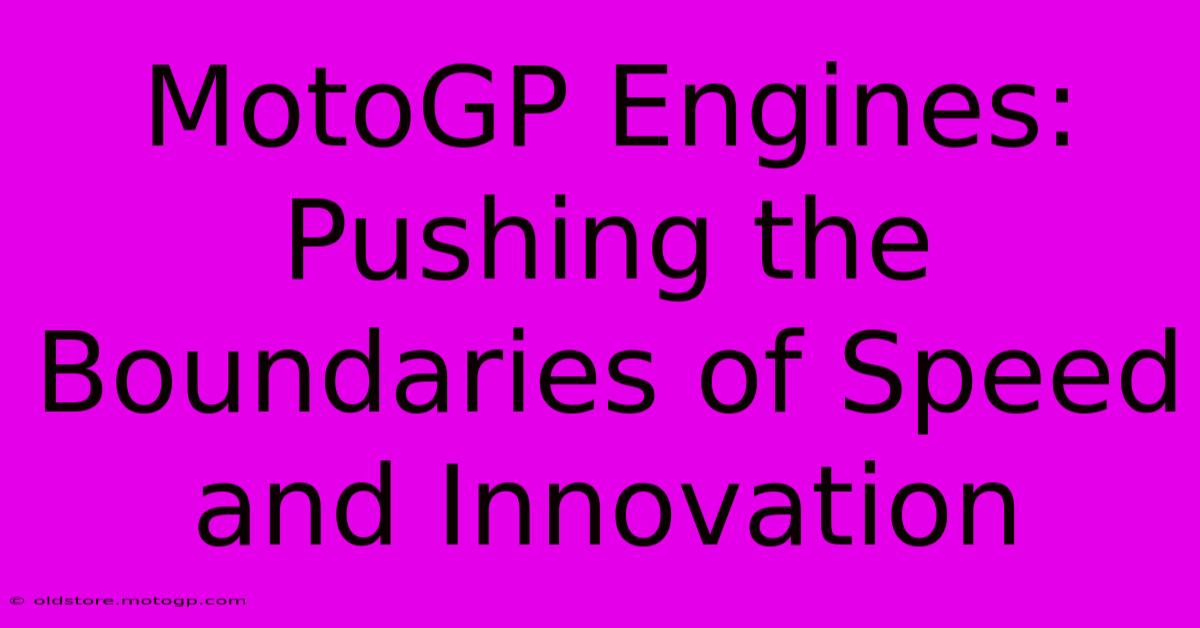MotoGP Engines: Pushing The Boundaries Of Speed And Innovation

Table of Contents
MotoGP Engines: Pushing the Boundaries of Speed and Innovation
MotoGP, the pinnacle of motorcycle racing, showcases breathtaking speeds and incredible feats of engineering. Central to this spectacle are the MotoGP engines, marvels of technology constantly pushing the boundaries of performance and innovation. This article delves into the heart of these racing beasts, exploring their design, evolution, and the relentless pursuit of speed and efficiency.
The Heart of the Beast: MotoGP Engine Specifications
MotoGP engines are highly specialized, four-stroke, inline four-cylinder powerhouses, typically boasting a capacity of 1000cc. These aren't your average production motorcycle engines; they're meticulously crafted for maximum power output and minimal weight. Key features often include:
- High RPM capabilities: These engines rev to incredibly high RPMs, often exceeding 16,000 rpm, maximizing power delivery.
- Sophisticated electronics: Sophisticated engine management systems, including seamless shift transmissions and advanced traction control, are crucial for managing the immense power output.
- Lightweight materials: Extensive use of lightweight materials like titanium, magnesium, and carbon fiber is essential to reduce overall weight and improve handling.
- Pneumatic valve actuation: Some manufacturers employ pneumatic valve actuation systems for precise valve control at high RPMs, contributing to increased power and efficiency.
- Restricted engine design: Strict regulations govern engine design, limiting factors like bore and stroke dimensions and the number of cylinders to ensure a level playing field.
Evolution of MotoGP Engines
The evolution of MotoGP engines is a continuous arms race of innovation. From the two-stroke era to the current four-stroke dominance, engine technology has dramatically improved. Significant advancements include:
- Transition from two-stroke to four-stroke: The shift to four-stroke engines in 2002 marked a paradigm shift, demanding new engineering solutions and pushing the limits of four-stroke technology.
- Increased displacement: The engine capacity has evolved over the years, leading to increased power and torque.
- Improved fuel efficiency: Despite the increased power, advancements in engine design and fuel injection systems have led to improved fuel efficiency.
- Sophisticated electronics: The integration of advanced electronics has significantly enhanced engine performance and rider control.
Fueling the Frenzy: Fuel and Lubricants
The fuel used in MotoGP is specifically formulated to provide optimal performance and combustion. It's meticulously engineered to ensure consistent power delivery across varying track conditions and temperatures. Similarly, the lubricants are specially designed to withstand the extreme temperatures and stresses placed upon the engine during a race.
The Future of MotoGP Engines: Sustainable Speed
While pushing the boundaries of speed is paramount, the future of MotoGP engines is increasingly focused on sustainability. Manufacturers are exploring alternative fuels and more efficient combustion technologies to reduce the environmental impact of racing. This includes:
- Biofuels: The incorporation of biofuels is gaining traction as a way to reduce reliance on fossil fuels.
- Hybrid technology: The potential use of hybrid technology is being explored to improve efficiency and reduce emissions.
- Sustainable materials: The use of more sustainable materials in engine construction is also gaining momentum.
Conclusion: A Symphony of Speed and Innovation
MotoGP engines are not just powerful machines; they're testaments to human ingenuity and a relentless pursuit of excellence. They represent a perfect blend of raw power, precision engineering, and cutting-edge technology, constantly evolving to push the boundaries of speed and innovation. As the sport continues to advance, we can anticipate even more exciting developments in engine technology, driving the sport forward into a thrilling and sustainable future.

Thank you for visiting our website wich cover about MotoGP Engines: Pushing The Boundaries Of Speed And Innovation. We hope the information provided has been useful to you. Feel free to contact us if you have any questions or need further assistance. See you next time and dont miss to bookmark.
Featured Posts
-
Grand Prix Red Bull Feel The Adrenaline
Feb 19, 2025
-
F1 Austin Feel The Rhythm Of The Race
Feb 19, 2025
-
Moto Gp Images The Perfect Gift For Any Racing Enthusiast
Feb 19, 2025
-
F1 Grid Positions How They Affect Overtaking
Feb 19, 2025
-
The Definitive Cota Austin Parking Map
Feb 19, 2025
